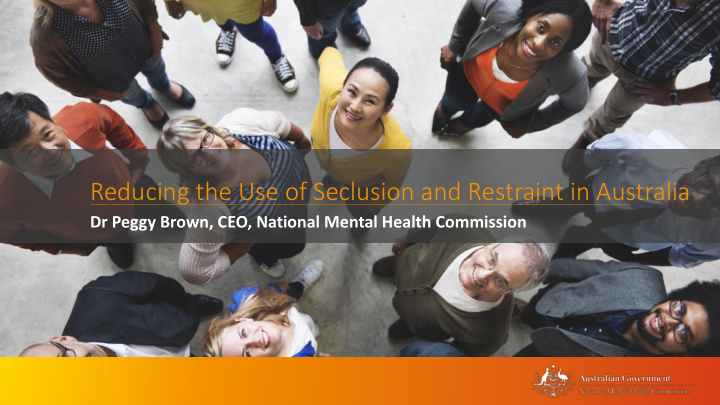



Reducing the Use of Seclusion and Restraint in Australia Dr Peggy Brown, CEO, National Mental Health Commission
“Forget about all the reasons why something may not work. You only need to find one good reason why it will.” Dr Robert Anthony
Why Focus on Seclusion and Restraint? • The use of seclusion and restraints is not therapeutic • No evidence-based research that supports the idea that either is therapeutic • Seclusion and restraints do not keep people safe • In contrast, the harm associated with their use is well documented - physical, emotional and mental harm – for consumers and staff
The Beginning of f the Jo Journey • National safety priorities in mental health: a national plan for reducing harm (2005) • Prepared by the Safety and Quality Partnership Subcommittee of the Mental Health Standing Committee • Genesis of National Seclusion and Restraint Project originated in a IIMHL match in 2005 when Bob Glover (NASMHPD) visited Canberra
‘6 core strategies’ framework • Leadership towards organisational change • Use of data to inform practice • Workforce development • Use of S/R prevention tools e.g. sensory modulation, de-escalation plans • Consumer roles in inpatient settings • Debriefing techniques
National Seclusion and Restraint Project 6 components 1. Beacon demonstration project 2. International study tours 3. National documentation – definitions, principles, procedures, audit tool 4. Data collection and reporting 5. Core training and education principles 6. Community of practice
Challenges • Challenging the status quo and changing the organisational culture takes courage • Industrial concerns - union • Engaging medical staff probably most difficult • Legislation - ?should legislation change • Design of new units - ?include seclusion rooms or not • Getting data published in the public domain • Sustainability – embedding the changes to last beyond the personal drivers
Keys to Success • Vision & Values • Leadership • Partnering with consumers • Focus on safety and quality • Data and measurement • Sustaining focus
The ACT Experience • Executive commitment and clinical leadership • Attended national forums • Change champions - Orient new staff to new ways of working • Environmental changes including comfort/sensory rooms • Used consumer voice to help drive change • Individual consumer assessments • Seclusion review implemented with strong consumer input • Consumer-led research • Used data regularly to inform progress - actively monitored use over time • Celebrated success and promoted achievements
Continuing the jo journey • The National Seclusion and Restraint Project finished in 2009 • SQPSC has maintained a focus on reducing the use of seclusion; now looking at restraint as well – including physical, mechanical and chemical • SQPSC worked with MHISSC and AIHW to develop a minimum data set - Public reporting now occurring • National forums continue to be held annually • The National Mental Health Consumer and Carer Forum published a statement on reducing seclusion and restraint • The National Mental Health Commission also launched a Seclusion and Restraint Declaration in 2013 and subsequently lead a project to look at best practice in reducing and eliminating seclusion and restraint
Think it. . Believe It It. . Change It It.
Questi tions – Peggy Brown Restructure and policy changes are common in mental health services, but real changes in practice which challenge deep-rooted organisational and professional cultures are much more rare. • If you have been involved in organisational culture change, what was your role and how did you experience it? What worked well and what didn't? What did you learn? Disruption and innovation are hallmarks of the 21st century, and should bring a willingness to tolerate failure in the quest for improvement. • How can we empower individuals in risk averse health services to change outdated systems? Questions – David id Covington • Core business? Secondary focus? Peripheral matter? Off the grid? How would an outsider describe the approach to suicide care in your healthcare system? • Think blue sky: what other ‘impossible challenge’ should be mental health’s next big hairy, audacious dream? • What leadership practices shift teams from siege mentality to marching towards innovation and new expectations and outcomes?
Recommend
More recommend